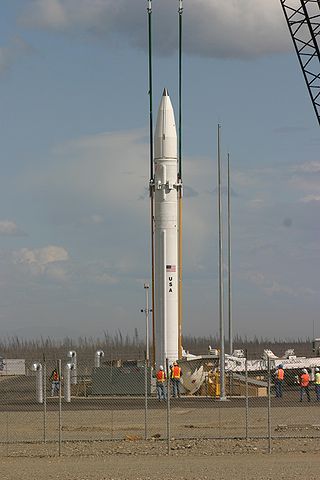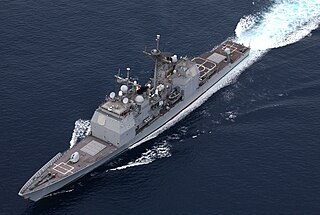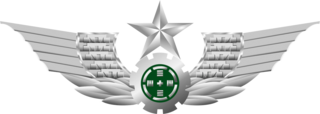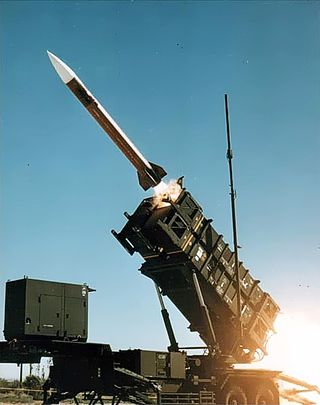Related Research Articles

An anti-ballistic missile (ABM) is a surface-to-air missile designed to counter ballistic missiles. Ballistic missiles are used to deliver nuclear, chemical, biological, or conventional warheads in a ballistic flight trajectory. The term "anti-ballistic missile" is a generic term conveying a system designed to intercept and destroy any type of ballistic threat; however, it is commonly used for systems specifically designed to counter intercontinental ballistic missiles (ICBMs).
The United States Armed Forces are the military forces of the United States. The armed forces consists of six service branches: the Army, Marine Corps, Navy, Air Force, Space Force, and Coast Guard. All six armed services are among the eight uniformed services of the United States.

North American Aerospace Defense Command, known until March 1981 as the North American Air Defense Command, is a combined organization of the United States and Canada that provides aerospace warning, air sovereignty, and protection for Canada and the continental United States.

The MIM-104 Patriot is a surface-to-air missile (SAM) system, the primary such system used by the United States Army and several allied states. It is manufactured by the U.S. defense contractor Raytheon and derives its name from the radar component of the weapon system. The AN/MPQ-53 at the heart of the system is known as the "Phased Array Tracking Radar to Intercept on Target," which is a backronym for "Patriot". In 1984, the Patriot system began to replace the Nike Hercules system as the U.S. Army's primary high to medium air defense (HIMAD) system and the MIM-23 Hawk system as the U.S. Army's medium tactical air defense system. In addition to these roles, Patriot has been given a function in the U.S. Army's anti-ballistic missile (ABM) system. The system is expected to stay fielded until at least 2040.

The Aegis Combat System is an American integrated naval weapons system, which uses computers and radars to track and guide weapons to destroy enemy targets. It was developed by the Missile and Surface Radar Division of RCA, and it is now produced by Lockheed Martin.
The Medium Extended Air Defense System (MEADS) is a ground-mobile air and missile defense system intended to replace the Patriot missile system through a NATO-managed development. The program is a development of the United States, Germany and Italy.

The United States Army Space and Missile Defense Command (USASMDC) is the Army Service Component Command (ASCC) for United States Strategic Command and United States Space Command. It was established in 1985 as the Army Strategic Defense Command, responsible for ballistic missile defense. In 1992, it merged with Army Space Command to become Army Space and Strategic Defense Command. In 1997, it became an Army Major Command and was redesignated Army Space and Missile Defense Command.

Missile defense is a system, weapon, or technology involved in the detection, tracking, interception, and also the destruction of attacking missiles. Conceived as a defense against nuclear-armed intercontinental ballistic missiles (ICBMs), its application has broadened to include shorter-ranged non-nuclear tactical and theater missiles.

The People's Liberation Army Ground Force is the land-based service branch of the People's Liberation Army and the largest and oldest branch of the entire Chinese armed forces. The PLAGF can trace its lineage from 1927 as the Chinese Red Army; however, it was not officially established until 1948.

The Field Artillery Branch is a combat arms branch of the United States Army that is responsible for field artillery.

The Republic of China Air Force, also retroactively known by its historical name the Chinese Air Force and colloquially referred to as the Taiwanese Air Force, is the military aviation branch of the Republic of China Armed Forces, based in Taiwan since 1949. The ROCAF was founded in 1920 by the Kuomintang. While its historical name is sometimes used especially in domestic circles, it is not used as often internationally due to the current ambiguous political status of Taiwan and to avoid confusion with the People's Liberation Army Air Force of the People's Republic of China (PRC).

The reorganization plan of the United States Army was implemented from 2006 to 2016 under the direction of the Brigade Modernization Command. This effort formally began in 2006 when General Peter Schoomaker was given the support to move the Army from its Cold War divisional orientation to a full-spectrum capability with fully manned, equipped and trained brigades; this effort was completed by the end of 2016. It has been the most comprehensive reorganization since World War II and included modular combat brigades, support brigades, and command headquarters, as well as rebalancing the active and reserve components.

The Combat Capabilities Development Command, is a subordinate command of the U.S. Army Futures Command. RDECOM was tasked with "creating, integrating, and delivering technology-enabled solutions" to the U.S. Army. It is headquartered at Aberdeen Proving Ground in Maryland.
Plug-and-fight is the military equivalent of plug and play as applied to commercial and personal computer systems. Plug-and-fight refers to the capability of certain large military systems such as the Medium Extended Air Defense System (MEADS) to automatically recognize and assemble various system elements, like sensors, weapons, and control nodes, into a single integrated supersystem or system-of-systems. Plug-and-fight systems can be rapidly reconfigured without interrupting operations – adding, removing, and rearranging system elements in response to evolving threats and changing defense strategies. The architecture of such modular systems is often described as netted-distributed. Sensors, shooters, and tactical operations centers (TOC) simply act as nodes on the network, and a military commander can dynamically add or subtract these elements as the situation dictates without shutting the system down.

Continental Air Defense Command (CONAD) was a Unified Combatant Command of the United States Department of Defense, tasked with air defense for the Continental United States. It comprised Army, Air Force, and Navy components. It included Army Project Nike missiles anti-aircraft defenses and USAF interceptors. The primary purpose of continental air defense during the CONAD period was to provide sufficient attack warning of a Soviet bomber air raid to ensure Strategic Air Command could launch a counterattack without being destroyed. CONAD controlled nuclear air defense weapons such as the 10 kiloton W-40 nuclear warhead on the CIM-10B BOMARC. The command was disestablished in 1975, and Aerospace Defense Command became the major U.S. component of North American Air Defense Command (NORAD).
The transformation of the United States Army is part of a strategy using Multi-Domain Operations (MDO). In 2019, the planning was for Large Scale ground Combat Operations at echelons above the brigade combat team. Multi-Domain Task Forces operate in a combatant commander's theater.
In air and missile defense (AMD), the Integrated Air-and-Missile Defense system (IAMD) is an SMDC research program to augment the aging surface-to-air missile defense systems and to provide the United States Army with a low-cost, but effective complement to kinetic energy solutions to take out air threats. Brigade level higher energy lasers are used in truck mounted systems called HELMTT. At lower levels, the Army needs to develop interceptors that don't cost more than small, unmanned aircraft systems. In early research they have successfully used 5-kilowatt lasers on a Stryker combat vehicle. The Mobile Expeditionary High-Energy Laser (MEHEL) was used at MFIX at Fort Sill, Oklahoma, in the first half of April, 2017.

The United States Army Futures Command (AFC) is a United States Army command that runs modernization projects. It is headquartered in Austin, Texas.

The United States Army Integrated Air and Missile Defense [IAMD] Battle Command System (IBCS) is a plug and fight network intended to let any defensive sensor feed its data to any available weapon system. The system is designed to shoot down short, medium, and intermediate range ballistic missiles in their terminal phase by intercepting with a hit-to-kill approach. IBCS has been developed since 2004, with the aim to replace Raytheon's Patriot missile (SAM) engagement control station (ECS), along with seven other forms of ABM defense command systems. In 2022, IBCS successfully completed initial operational test and evaluation (IOT&E), and was approved for full-rate production in 2023.
References
- ↑ Growing mission for future Army battle command system accounts for delays By: Jen Judson, March 2, 2018, defense news website.
- ↑ Video: Army missiles acquisition chief: IBCS is the foundation for the Army's air & missile defense forces, Defense News website.
- ↑ New tech from Futures Command ‘designed, built, tested with soldiers’ to get it there faster. by Todd South, October 20, 2019
